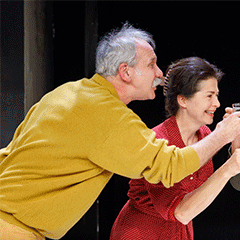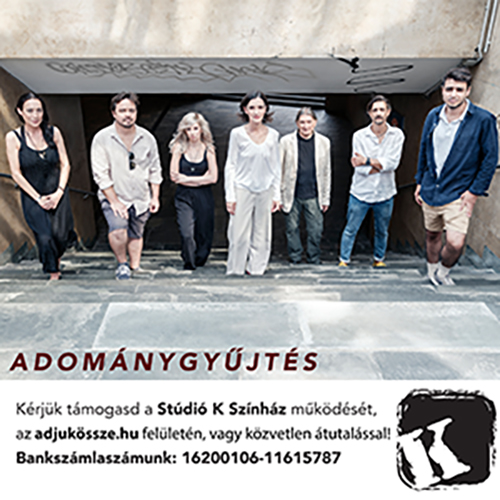Not safe but respectful
In our upcoming project of American – Hungarian collaborations we would like to deal with the problem of how to approach the question of PC (political correctness) when it comes to the performing arts? More and more debates are centred around ‘diversity’ and how diversity appears in the performing arts: who are the performers, directors, writers? What about representation? How can we reconcile aesthetic freedom and the ethical need for diversity? Upor László talks with USA-based creators, theoreticians and university professors about these important, actual and difficult questions in our new series of interviews.
Alisa Solomon, New York-based Writer, Critic, Professor at Columbia University in conversation with Laszlo Upor, dramaturg, translator and University Professor from Budapest

Alisa Solomon. Photo: Ed Ellington, III.
Laszlo Upor: This is our first piece in a series of interviews about the so-called “political correctness” in relation to the freedom of art, freedom of speech in general – with a focus on theatre.
We often ask ourselves whose sensitivity we are defending and how should we do that without giving up the freedom of speech or the freedom of artistic creation…
Alisa Solomon: I would begin by contesting the very way this conversation’s been framed. I object to the use of the term political correctness – which is a kind of eighties-nineties epithet from the right in the US that uses other terms now, like cancel culture and so on. The minute you use one of those phrases, you have already indicated that you are dismissing what might be some legitimate concerns that people are raising. It is very easy to go immediately to examples that seem the extreme. “Look at this terrible example, look at how horrible these people are, look at how they want to supress the speech of others – and we can’t allow it.” It’s more important just to back way up and to consider what are the actual concerns and issues that might sometimes lead to what may look excessive but have some important values underneath.
– True. But sometimes an extreme example may help to raise awareness. Once the shock is over it is easy to point out: “Listen, this is the real issue, this is the actual concern and whether the actors in our example went too far or not, we must deal with the actual problem”.
– There are a lot of things to untangle there. The first thing I’d ask: is anybody’s expression really curtailed? There is a lot of objections against what’s now called “cancel culture”. What people are really complaining about is being held accountable. They are not silenced. They still publish, they still make work, they still get interviewed, they still tweet, their voices are still out in the public, but they are crying about being cancelled because they are being criticised for saying things that maybe they should be accountable for. That’s the first thing: are people really being censored? Or are people being criticized? Those aren’t the same.
– Absolutely not. But then comes the next big question: who is there to set the rules, the standards? What is the right way of collective self-defence? How do we defend ourselves as a society against views and expressions that are not tolerable? Are there some ultimate values written somewhere on “tablets” like the ten commandments?
– Far be it from me to say, let the market decide. (laughs) I don’t think there are rules, or there is anybody authorised to set the rules. Unless we want to be Stalinists. Especially when talking about freedom of expression, or maybe more specifically for us, what happens in the theatre. We are not going to set rules. I mean, who is “we” anyway?
– Exactly.
– But I think we can invite and foster and encourage platforms for a diversity of voices, discussing what’s happening. And artists will respond to that discussion, or not. Some will be defensive and cry censorship when in fact that’s not what’s happening. Maybe they are subjected to critique from people who hadn’t been part of the conversation in the past. That’s changing and that may be a little scary to artists who had free rein and thought they deserved to have that free rein and they now are facing critique. And that’s not just critique from the same handful of, in our country, older white men who dominate the theatre criticism discussion. And social media – with all its many faults and despite sometimes creating some space for fomenting hysteria –is also democratising and bringing many more voices into the conversation. So, I don’t think it’s about setting rules – it’s about responding to specific work.
– Responding to a work means: after the work’s been done. Not ruling what could be done beforehand, right?
– Yes. This is how, usually critical discourse happens. (laughs) Though we might take from these discussions some suggestions, some best practices for how we go ahead and make work. So, for example take some audience’s reaction to the representation of sexual violence against women on stage. Are these people objecting or are they simply misreading? How to deal with that conundrum? If you are a theatre director, a theatre company, a playwright – making work that has, let’s say, a rape in it – it is worthwhile to ask some questions in the rehearsal room, right? “Is this simply representing violence or is it putting a critical frame around it?” You may learn from the reactions. Instead of being just defensive and saying, “You stupid literal people who don’t understand a critical frame,” to step back and say, “OK, this seems overly literal, this isn’t what we were intending. What might we have done to make clearer that we aren’t trying simply to replicate violence and trauma and the demeaning of women on stage, but we’re trying to say something about that?” And maybe ask yourself: can we say something about that without representing that violence if we’re really being honest? That’s a useful conversation to bring into the rehearsal room. And one of the ways you bring that conversation to the rehearsal room is to not just be defensive when critiques are made but also by maybe bringing people into the rehearsal process, to have a different perspective. Not to censor you, not to say you can’t do this but to have dramaturgs, basically, who…
– “People’s dramaturgs”.
– Yeah!… who have a different range of experiences and perspectives and can say: you know if you stage this this way, here are some possible responses…
– This is the point that I very often make when I’m part of a creation process. “Listen: what you do now means this, see? Or: what you do now may mean this or this or this…”
– Exactly.
– “…and if any of those three is opposite to your intentions, we have to do something in order to eliminate/exclude that.” My role as a dramaturg, as a critic, or even as an ordinary audience member, is to face them to what they did or what they are doing; and if anything of my understanding conflicts with their actual intentions, they must be alert. On the other hand, I agree with many of our predecessors that art should be subversive. If we are too careful not to disturb people, we may lose something essential. In other words: don’t tell the audience how to understand or how to make sense of what they see. Confusion is a very important part of the theatre experience.
– I agree!
– Many believe in shock therapy and insist that we should cause some kind of trauma by a piece of art and not comfort our audiences. Make them feel, make them think much after they left the auditorium. How do we find the balance? How much do we limit ourselves thinking: ok, this might be too much?
– I agree. But those questions have to be asked honestly and not just use as an excuse. “Oh, I’m going to do this because after all I can’t protect the audience.”
– And there is a very-very fine line if you tell your audience how to read what they see. If something “bad” happens on stage but you immediately put a frame around it with blinking red letters: “Listen this is something I think is bad” – you may ruin the effect you created.
– Absolutely. But I don’t think there’s any real contradiction here. What you said about the dramaturgical process makes plenty of room for that. “What is our intention here?” Maybe the intention is to disturb and confuse and open questions. But there are also ways to be responsible… There was some rhetoric floating around in the US for a few years about safe space. A classroom should be a safe space, theatre should be a safe space. I always begin my classes by saying to my students, this classroom is not a safe space, ideas are dangerous. The debates we’ll have should unsettle you, make you rethink things. This is a respectful space, but not safe. For me that’s a worthwhile distinction.
– A very important one. So how safe should theatre be for the audience?
– It’s not!
– Or respectful?
– Those are two different things…
– Of course.
– …and it’s very tricky. I’m sure like me, you’ve been offended in theatre many times by something. By the ideology of the work, by just bad acting, by any number of things. We take offence. And, you know, we go out, and have a beer and rail against it. It’s part of the deal to be offended. And also, be thrilled and excited. Any number of feelings you might have. You can offend. But: should you? Again: what is your intention? There are ways to represent racism, misogyny, homophobia, xenophobia without being racist, misogynist, homophobic, xenophobic etc. And those are really hard questions for artists to grapple with when they are making work. But I think they need to be considered.
– OK, you are often offended but then go out and have a beer, debate it out of your system – maybe with the creators even. But in the audience, just as in the rest of the society, present are the more privileged and the underprivileged. We are – you and me and many others – the privileged, thanks to our education, our experience of freedom etc., so we can deal with these little conflicts easier than other audience members. So how do you aim as a creator when you see your imaginary audience? Do you create art for Professor Alisa Solomon or for John Smith who didn’t finish elementary school and doesn’t have the armour the two of us do? How much do you have to imagine your audience? How much you have to limit your imagination when thinking: hey, there will be some audience members who may not be able to decipher my wonderful artistic view?
– There always will be, and it won’t always be determined by how much education or exposure or familiarity they do or they don’t have – there might be any number of reasons. And nobody speaks for an entire community. A couple of years ago when Slave Play by Jeremy O. Harris, a gay African American playwright, opened it was both protested by African American people offended by it and defended by African American people who thought it was an important ground-breaking critique of the persistence of American racism. And also embraced by white audiences and critics and by others who are not white nor African American. So, there’s never any single response that you can count on from any particular community. It goes back to a very honest questioning of oneself in a rehearsal room of what values you are trying to put across. There always will be occasions where someone tries – as the old example goes — to run on the stage to save Desdemona. We could spend hours just to discuss gender and racial and representational implications of that play and that scene. That murder scene alone.
– I know, but no one thinks that that scene is to suggest that we should kill our wives.
– No. Not as far as I know. No. But there are different ways to stage that scene, right? It could be very graphic and violent. It can be very subtle. Directors can do all kinds of things. It could happen off stage.
– Just like in ancient Greek tragedies.
– It can be any number of things. No, it’s not suggesting that anybody should kill their wives but is it suggesting that black men are naturally violent?
– No. It portrays frustrated people who are cheated into believing something that isn’t true.
– Yes, of course.
– It isn’t about black people being worse than white people and black people killing their wives in situations where white people wouldn’t. I think it can’t be represented as…
– But I think it can be. I share your reading of the play. But it’s a fact that the character is a Moor. And his blackness is commented on in certain ways. And there are a lot of important Shakespeareans who have interesting things to say about the dynamics in that play and in that scene for which race is all-important. And it doesn’t mean, don’t do the play, it doesn’t mean Shakespeare is a racist and should be cancelled. It means, let’s talk about what we are actually seeing.
– I know, but the play doesn’t begin with that scene. The play begins with everyone hating him because he is black. The whole plot is turning the way it does not because he is black, but because he is regarded an alien in that community. The blame is not on him. If you blame anyone, you blame the community. And this is the total opposite of the message that he is a bad person because he is black.
– Right! That is a conventional and clear and proper reading of the play. But as we all know, what happens on stage never happens in a vacuum. It takes place amid all kinds of other cultural representations and ideas and laws and actions. There is no blank slate when you walk into a theatre.
– Something we touched earlier is representation which, again, is a very touchy matter. I don’t think anyone in their sane mind would disagree with the need of a wider representation of cultures and subcultures on stage. It really is important. In Hungary, for example, the range of actors is very limited, and several social groups are not represented on stage at all. And we should do something about it. But there is another aspect of the same question: some think that characters from a specific group should be portrayed by representatives of that part of the society. If I agree with that, then only Irish people can play Irish characters or only black people may portray black characters on stage – and that also means a black actor is not allowed to portray a white character.
– Here I disagree. I can’t speak to the Hungarian situation, but I can speak to the US one. It is a very complicated and nuanced matter that involves a number of factors. What kind of play is it? Is it realism? Is it surrealism? Is it some kind of weird experimental thing? So there’s that question. And there is the question of the surrounding culture and history. Representation, certainly in the US, is not an even playing field. And these controversies come up again and again. When half a dozen of years ago the Gilbert and Sullivan Society was going to do a Mikado and put out their posters with white actors in yellow face, that created a controversy – I think a legitimate controversy. Because we have a long history of stereotypical, caricatured portrayal of Asians in our culture, and very little other representation of Asian and Asian American culture. You can’t look at that one case in a vacuum. You must look at it in that wider context. So that’s one thing. The other thing is how whiteness is understood as the generic universal and other ethnic or racial categories are not: they are considered particulars and specifics. And related to that: what plays are considered canonical and so-called universal and what are not, and therefore how much does the racial, ethnic identity of the actor matter? It’s different if it’s Hamlet than if it’s A Raisin in the Sun. They just don’t occupy the same aesthetic, cultural, political, representational grounds. How much does the identity of the character matter to the plot? If you’re doing A Raisin in the Sun, and the whole plot hinges around a black family being restricted from moving into a neighbourhood, it’s really important that they’d be a black family. I mean that’s what the play is about. It’s not about “the human condition” in generic terms. Partly because we are not yet at a place where we realise that what happens particularly to a black family is the human condition.
– But then you mean, these plays have no chance to get on stage in Hungary.
– Maybe not. Maybe not. And one of the reasons it is very difficult to have this conversation is that to have this conversation often requires talking about recognisable, visually legible racial characteristics. And that’s a really uncomfortable thing to talk about. There was a dispute when, in a 2004 revival of Fiddler on the Roof, Alfredo Molina played Tevye. And there was all this false, absurd controversy about not having a Jewish actor playing Tevye and how terrible this was. We don’t – thank goodness! – have anymore (in most situations anyway) an idea of what a Jew looks like. And if we do then, maybe, Alfredo Molina looks like that as much as anybody else does. The actor needs to do his homework, yes, he has to understand the cultural background of his character, he has to learn how to make certain kinds of sounds, etcetera. Yes, he has to do his homework. But when you’re talking about an Asian character or a black character then we are talking about visually legible characteristics that make us, make me, uncomfortable to talk about and yet is part of why we are having this conversation at all. If the identity of the character matters to the plot, then, yes, it matters who those actors are.
– This is all is very clear, and I agree with most of it. But there is one point, that of realism or naturalism, you actually touched earlier. Theatre is not all realism, and the actor is not the character. If women should be portrayed by women and men should be portrayed by men and straight people by straight people etc. that makes a little difficult to argue for the colourblind casting of some productions.
– For me it doesn’t. And again, this is the US context. There is a distinction between colourblind casting and colour-conscious casting. Let me elaborate a little because this is a really important distinction. When plays enter the western canon, plays that show humankind in existential, metaphysical conflict, crisis what have you… when it’s taken to be about the human condition, it doesn’t matter what actor plays that role. What’s more, a white actor of, say, Irish background has no more cultural affinity for playing Torvald than an African American actor has. They have the same access, the same experience, the same need for doing homework to portray that character who is considered “universal” as anyone else. So, you aren’t being any more authentic with a white American actor whose great-great grandparents came from Ireland than you are with an African American actor whose great-great-great-grandparents were enslaved and brought in chains to this country. They have the same access to playing Torvald, the same lack of cultural affinity for late 19th-century Norway and the same ways of bringing their own personal experiences to inform that role and to do their homework. Or Hamlet, or Arkadina. Any of these classical roles. They occupy a space– and maybe shouldn’t, but historically they do – of presumed universality that no longer connects to a particular cultural background of the actor portraying those roles. Whereas, again, going back to A Raisin in the Sun or the plays of August Wilson or of Suzan-Lori Parks or other really important African American playwrights, those are black characters in a particular situation and need to read as black on the stage, therefore require black actors.
– We simply have no black actors and we have no Asian actors, so that limits the range of plays we can put on stage in Hungary.
– Yes. Yes, it does. And I guess the question I would bring into consideration is what values are being upheld when you choose not to do those plays in full productions – and maybe come up with some other creative ways for audiences to engage them? And, yes, this is a sacrifice for the Hungarian public and again for Hungarian actors and designers and directors and so on who might want to engage to that work directly. It’s a sacrifice. What value is being upheld on the other hand? It isn’t just to punish the Hungarians for the demographics of the country. That’s not the idea.
– We are all used to portray Asian, African, American, Irish, Hungarian, Czech and other characters and see them all portrayed by Hungarian speaking Hungarian actors whose faces happen to be white. So, I think the audiences and the creators in my country (and in the neighbouring countries) are used to that kind of leap. It’s just natural that the person we see on stage is a black person. The other is Italian. We need to believe they are black or Italian, portrayed by people who are our neighbours and speak Hungarian (or Rumanian or Czech). As part of the willing suspension of disbelief. So, I’m not sure I agree with you on this particular point.
– That’s okay. And I’m not sure I entirely agree with myself. (smiles) I mostly do. It’s extremely touchy and for good reasons. For good reasons.
A beszélgetés magyarul ITT olvasható!









